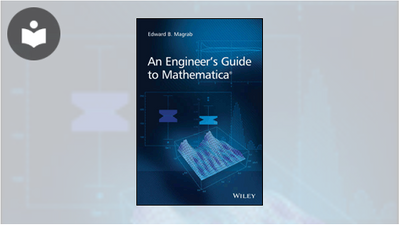An Engineer's Guide to Mathematica
- 4h 22m
- Edward B. Magrab
- John Wiley & Sons (UK)
- 2014
An Engineer’s Guide to Mathematica enables the reader to attain the skills to create Mathematica 9 programs that solve a wide range of engineering problems and that display the results with annotated graphics. This book can be used to learn Mathematica, as a companion to engineering texts, and also as a reference for obtaining numerical and symbolic solutions to a wide range of engineering topics. The material is presented in an engineering context and the creation of interactive graphics is emphasized.
The first part of the book introduces Mathematica’s syntax and commands useful in solving engineering problems. Tables are used extensively to illustrate families of commands and the effects that different options have on their output. From these tables, one can easily determine which options will satisfy one’s current needs. The order of the material is introduced so that the engineering applicability of the examples increases as one progresses through the chapters. The second part of the book obtains solutions to representative classes of problems in a wide range of engineering specialties. Here, the majority of the solutions are presented as interactive graphics so that the results can be explored parametrically.
Key features:
- Material is based on Mathematica 9
- Presents over 85 examples on a wide range of engineering topics, including vibrations, controls, fluids, heat transfer, structures, statistics, engineering mathematics, and optimization
- Each chapter contains a summary table of the Mathematica commands used for ease of reference
- Includes a table of applications summarizing all of the engineering examples presented.
An Engineer’s Guide to Mathematica is a must-read reference for practitioners, and graduate and undergraduate students who want to learn how to solve engineering problems with Mathematica.
About the Author
Dr. Magrab is Emeritus Professor of Mechanical Engineering at the University of Maryland, College Park, Maryland. Before joining the University of Maryland, he was Chief of the Sound Section, head of the Robot Metrology Group, and led the development of the vertical machining workstation in the Automated Manufacturing Research Facility at the National Institute of Standards and Technology (NIST). He went to NIST after being a professor in the Department of Mechanics at the Catholic University of America in Washington DC. Dr. Magrab is a Life Fellow of the American Society of Mechanical Engineers and a registered professional engineer in Maryland. He has authored eight other textbooks, published numerous journal articles, and has over 35 years of university-level teaching experience on many engineering subjects. His research interests include analytical and experimental investigations in vibrations, acoustics, and the integration of design and manufacturing. He holds one patent.
In this Book
-
Table of Engineering Applications
-
Mathematica® Environment and Basic Syntax
-
List Creation and Manipulation—Vectors and Matrices
-
User-Created Functions, Repetitive Operations, and Conditionals
-
Symbolic Operations
-
Numerical Evaluations of Equations
-
Graphics
-
Interactive Graphics
-
Vibrations of Spring–Mass Systems and Thin Beams
-
Statistics
-
Control Systems and Signal Processing
-
Heat Transfer and Fluid Mechanics



